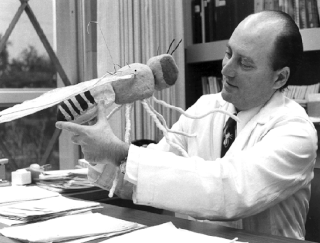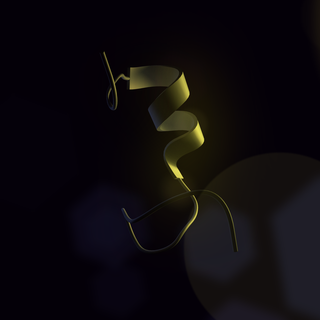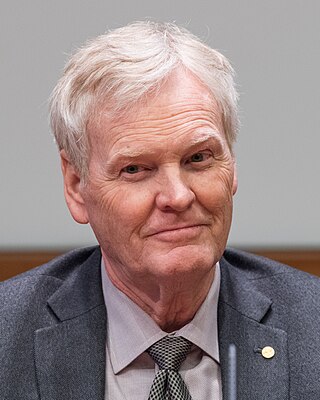Related Research Articles

Seymour Benzer was an American physicist, molecular biologist and behavioral geneticist. His career began during the molecular biology revolution of the 1950s, and he eventually rose to prominence in the fields of molecular and behavioral genetics. He led a productive genetics research lab both at Purdue University and as the James G. Boswell Professor of Neuroscience, emeritus, at the California Institute of Technology.

CLOCK is a gene encoding a basic helix-loop-helix-PAS transcription factor that is known to affect both the persistence and period of circadian rhythms.
Timeless (tim) is a gene in multiple species but is most notable for its role in Drosophila for encoding TIM, an essential protein that regulates circadian rhythm. Timeless mRNA and protein oscillate rhythmically with time as part of a transcription-translation negative feedback loop involving the period (per) gene and its protein.
Period (per) is a gene located on the X chromosome of Drosophila melanogaster. Oscillations in levels of both per transcript and its corresponding protein PER have a period of approximately 24 hours and together play a central role in the molecular mechanism of the Drosophila biological clock driving circadian rhythms in eclosion and locomotor activity. Mutations in the per gene can shorten (perS), lengthen (perL), and even abolish (per0) the period of the circadian rhythm.

Period circadian protein homolog 1 is a protein in humans that is encoded by the PER1 gene.
In molecular biology, an oscillating gene is a gene that is expressed in a rhythmic pattern or in periodic cycles. Oscillating genes are usually circadian and can be identified by periodic changes in the state of an organism. Circadian rhythms, controlled by oscillating genes, have a period of approximately 24 hours. For example, plant leaves opening and closing at different times of the day or the sleep-wake schedule of animals can all include circadian rhythms. Other periods are also possible, such as 29.5 days resulting from circalunar rhythms or 12.4 hours resulting from circatidal rhythms. Oscillating genes include both core clock component genes and output genes. A core clock component gene is a gene necessary for to the pacemaker. However, an output oscillating gene, such as the AVP gene, is rhythmic but not necessary to the pacemaker.
Colin Stephenson Pittendrigh was a British-born biologist who spent most of his adult life in the United States. Pittendrigh is regarded as the "father of the biological clock," and founded the modern field of chronobiology alongside Jürgen Aschoff and Erwin Bünning. He is known for his careful descriptions of the properties of the circadian clock in Drosophila and other species, and providing the first formal models of how circadian rhythms entrain (synchronize) to local light-dark cycles.
Pigment dispersing factor (pdf) is a gene that encodes the protein PDF, which is part of a large family of neuropeptides. Its hormonal product, pigment dispersing hormone (PDH), was named for the diurnal pigment movement effect it has in crustacean retinal cells upon its initial discovery in the central nervous system of arthropods. The movement and aggregation of pigments in retina cells and extra-retinal cells is hypothesized to be under a split hormonal control mechanism. One hormonal set is responsible for concentrating chromatophoral pigment by responding to changes in the organism's exposure time to darkness. Another hormonal set is responsible for dispersion and responds to the light cycle. However, insect pdf genes do not function in such pigment migration since they lack the chromatophore.

Cycle (cyc) is a gene in Drosophila melanogaster that encodes the CYCLE protein (CYC). The Cycle gene (cyc) is expressed in a variety of cell types in a circadian manner. It is involved in controlling both the sleep-wake cycle and circadian regulation of gene expression by promoting transcription in a negative feedback mechanism. The cyc gene is located on the left arm of chromosome 3 and codes for a transcription factor containing a basic helix–loop–helix (bHLH) domain and a PAS domain. The 2.17 kb cyc gene is divided into 5 coding exons totaling 1,625 base pairs which code for 413 aminos acid residues. Currently 19 alleles are known for cyc. Orthologs performing the same function in other species include basic helix-loop-helix ARNT-like protein 1 (ARNTL) and Aryl hydrocarbon receptor nuclear translocator-like 2 (ARNTL2).
Doubletime (DBT), also known as discs overgrown (DCO), is a gene that encodes the doubletime protein in fruit flies. Michael Young and his team at Rockefeller University first identified and characterized the gene in 1998.

Michael Morris Rosbash is an American geneticist and chronobiologist. Rosbash is a professor and researcher at Brandeis University and investigator at the Howard Hughes Medical Institute. Rosbash's research group cloned the Drosophila period gene in 1984 and proposed the Transcription Translation Negative Feedback Loop for circadian clocks in 1990. In 1998, they discovered the cycle gene, clock gene, and cryptochrome photoreceptor in Drosophila through the use of forward genetics, by first identifying the phenotype of a mutant and then determining the genetics behind the mutation. Rosbash was elected to the National Academy of Sciences in 2003. Along with Michael W. Young and Jeffrey C. Hall, he was awarded the 2017 Nobel Prize in Physiology or Medicine "for their discoveries of molecular mechanisms controlling the circadian rhythm".

Jeffrey Connor Hall is an American geneticist and chronobiologist. Hall is Professor Emeritus of Biology at Brandeis University and currently resides in Cambridge, Maine.

Michael Warren Young is an American biologist and geneticist. He has dedicated over three decades to research studying genetically controlled patterns of sleep and wakefulness within Drosophila melanogaster.
Paul H. Taghert is an American chronobiologist known for pioneering research on the roles and regulation of neuropeptide signaling in the brain using Drosophila melanogaster as a model. He is a professor of neuroscience in the Department of Neuroscience at Washington University in St. Louis.
Jeffrey L. Price is an American researcher and author in the fields of circadian rhythms and molecular biology. His chronobiology work with Drosophila melanogaster has led to the discoveries of the circadian genes timeless (tim) and doubletime (dbt), and the doubletime regulators spaghetti (SPAG) and bride of doubletime (BDBT).
Paul Hardin is an American scientist in the field of chronobiology and a pioneering researcher in the understanding of circadian clocks in flies and mammals. Hardin currently serves as a distinguished professor in the biology department at Texas A&M University. He is best known for his discovery of circadian oscillations in the mRNA of the clock gene Period (per), the importance of the E-Box in per activation, the interlocked feedback loops that control rhythms in activator gene transcription, and the circadian regulation of olfaction in Drosophila melanogaster. Born in a suburb of Chicago, Matteson, Illinois, Hardin currently resides in College Station, Texas, with his wife and three children.

Drosophila circadian rhythm is a daily 24-hour cycle of rest and activity in the fruit flies of the genus Drosophila. The biological process was discovered and is best understood in the species Drosophila melanogaster. Many behaviors are under circadian control including eclosion, locomotor activity, feeding, and mating. Locomotor activity is maximum at dawn and dusk, while eclosion is at dawn.
dClock (clk) is a gene located on the 3L chromosome of Drosophila melanogaster. Mapping and cloning of the gene indicates that it is the Drosophila homolog of the mouse gene CLOCK (mClock). The Jrk mutation disrupts the transcription cycling of per and tim and manifests dominant effects.
Ravi Allada is an Indian-American chronobiologist studying the circadian and homeostatic regulation of sleep primarily in the fruit fly Drosophila. He is currently the Executive Director of the Michigan Neuroscience Institute (MNI), a collective which connects neuroscience investigators across the University of Michigan to probe the mysteries of the brain on a cellular, molecular, and behavioral level. Working with Michael Rosbash, he positionally cloned the Drosophila Clock gene. In his laboratory at Northwestern, he discovered a conserved mechanism for circadian control of sleep-wake cycle, as well as circuit mechanisms that manage levels of sleep.

Eclosion assays are experimental procedures used to study the process of eclosion in insects, particularly in the model organism drosophila. Eclosion is the process in which an adult insect emerges from its pupal case, or a larval insect hatches from its egg. In holometabolous insects, the circadian clock regulates the timing of adult emergence. The daily rhythm of adult emergence in these insects was among the first circadian rhythms to be investigated. The circadian clock in these insects enforces a daily pattern of emergence by permitting or triggering eclosion during specific time frames and preventing emergence during other periods.
References
- ↑ Rosbash, Michael (April 9, 2015). "Ronald J. Konopka (1947–2015)". Cell. 161 (2): 187–188. doi: 10.1016/j.cell.2015.03.038 . PMID 26042238.
- ↑ Denlinger, David L.; J. M. Giebultowicz; David Stanley Saunders (2001). Insect timing: circadian rhythmicity to seasonality. Gulf Professional Publishing. p. 17. ISBN 978-0-444-50608-5 . Retrieved March 31, 2011.
- ↑ Greenspan, Ralph, (2003). "The 2003 Genetics Society of America Medal" Retrieved April 13, 2011.
- ↑ Barondes, S (2000) A Real-life Arrowsmith Finds His Sinclair Lewis Retrieved April 13, 2011.
- ↑ Weiner, Jonathan. "Time, Love, Memory: A Great Biologist and His Quest for the Origins of Behavior" Alfred A. Knopf, Inc, 1999
- ↑ Konopka, R.; Benzer, Seymour (1971). "Clock Mutants of Drosophila melanogaster". Proc. Natl. Acad. Sci. 68 (9): 2112–6. Bibcode:1971PNAS...68.2112K. doi: 10.1073/pnas.68.9.2112 . PMC 389363 . PMID 5002428.
- 1 2 Konopka, Ronald J (1987). "Genetics of Biological Rhythms in Drosophila". Annu. Rev. Genet. 21: 227–236. doi:10.1146/annurev.ge.21.120187.001303. PMID 3327464.
- ↑ Ishida N, Kaneko M, Allada R (August 1999). "Biological clocks". Proc. Natl. Acad. Sci. U.S.A. 96 (16): 8819–20. Bibcode:1999PNAS...96.8819I. doi: 10.1073/pnas.96.16.8819 . PMC 33693 . PMID 10430850.
- ↑ Konopka, RJ; Wells (1980). "Drosophila clock mutations affect the morphology of a brain neurosecretory cell group". Journal of Neurobiology. 11 (4): 411–415. doi:10.1002/neu.480110407. PMID 7400816.
- 1 2 Handler, A & Konopka, R (1979). "Transplantation of a circadian pacemaker in Drosophila". Nature. 279 (5710): 236–238. Bibcode:1979Natur.279..236H. doi:10.1038/279236a0. PMID 440433. S2CID 4369719.
- 1 2 Konopka RJ, Pittendrigh C, Orr D (2007). "Reciprocal behaviour associated with altered homeostasis and photosensitivity of Drosophila clock mutants". J. Neurogenet. 21 (4): 243–52. doi:10.1080/01677060701695391. PMID 18161586. S2CID 25159075.
- ↑ Pittendrigh CS, Daan S (1976). "A functional analysis of circadian pacemakers in nocturnal rodents V. Pacemaker structure: a clock for a seasons". J. Comp. Physiol. 106: 333–55. doi:10.1007/BF01417860. S2CID 206794951.
- 1 2 Dushay MS, Konopka RJ, Orr D, Greenacre ML, Kyriacou CP, Rosbash M, Hall JC (1990). "Phenotypic and genetic analysis of Clock, a new circadian rhythm mutant in Drosophila melanogaster". Genetics. 125 (3): 557–78. doi:10.1093/genetics/125.3.557. PMC 1204083 . PMID 2116357.
- 1 2 3 Konopka RJ, Smith RF, Orr D (1991). "Characterization of Andante, a new Drosophila clock mutant, and its interactions with other clock mutants". J. Neurogenet. 7 (2–3): 103–114. doi:10.3109/01677069109066214. PMID 2030465.